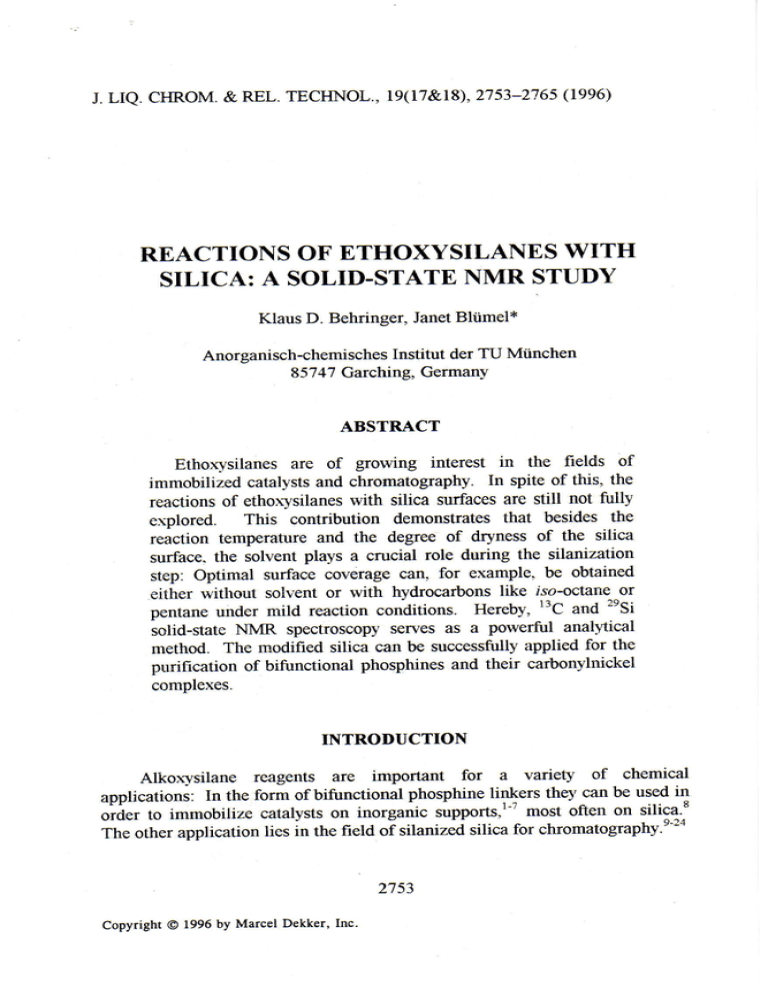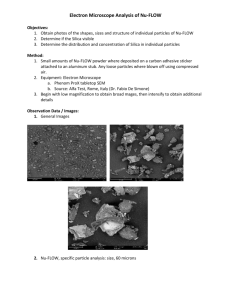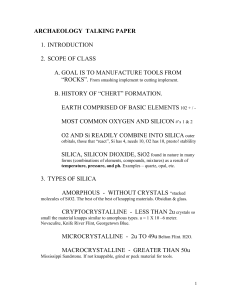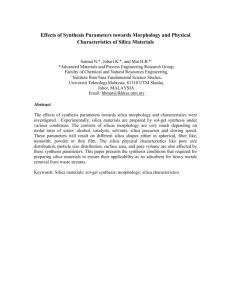WITH REACTIONS OF ETHOXYSILANES SILICA: A SOLID.STATE NMR STUDY
advertisement

(1996)
J. LIQ. CHROM.& REL. TECHNOL.,19(17&18),2'753-2765
REACTIONSOF ETHOXYSILANESWITH
SILICA: A SOLID.STATENMR STUDY
KlausD. Behringer,JanetBliimel*
Institutder TU Miinchen
Anorganisch-chemisches
85747Garching,Germany
ABSTRACT
Ethorysilanes are of growing interest in the fields of
immobilizedcatalystsand chromatography.In spiteof this' the
with silica surfacesare still not fully
reactionsof ethoxysilanes
explored. This contribution demonstratesthat besides the
reaction temperatureand the degreeof drynessof the silica
surface,the solventplays a crucial role during the silanization
step: Optimal surfacecoveragecan, for example,be obtained
or
either without solventor with hydrocarbonslike iso-octane
t'C and
"Si
pentaneunder mild reactionconditions. Hereby,
iolid-state NMR spectroscopyservesas a porverful analvtical
appliedfor the
method. The modifiedsilica can be successfirlly
purificationof bifunctionalphosphinesand their carbonylnickel
complexes.
INTRODUCTION
Alko4vsilane reagents are imporlant for a variety of chemical
applications:In the form of bifunctionalphosphinelinkers they canbe usedin
order to imrnobilizecatalystson inorganic supports,l-?most often on silica.s
The otherapplicationlies in the field of silanizedsilicafor chromatography.e-z4
2753
Copyright @ 1996 by Marcel Dekker, Inc.
2754
BEHRINGERANDBLUMEL
The most powerful method in order to characterizesilanemodified
siiica is solid-stateNMR spectroscopy-3-?Jr-2e
Using Magic Angle Spinning
(MAS,2'-21and CrossPolarization(Cp,tt-") the surfacerp"ii*, canbe detected
rvithoutanydifficultiesarisingfrom thebulk material.
The advantages
ofalkoxysilanesascomparedto chlorosilanes,
are that no
acidic blproductsare formed upon reactionwith silica, which could destroy
sensitivetransition metal complexeswhen they are immobilizedon silica or
chromatographed.Furthermore,due to addition reactionsof alkoxysilanesto
surfacesiloxanegroups,thereis no needfor "endcapping"in a further step.3l
However,in contrastto the reactionsof chlorosilanes,comparativelyfetv
studies deal with the reactions of ethoxysilanes with silica
surfaces.o'5'1i'13'1s'22'24'31
Triethoxysilanesare most interesting.becausethey
shouldprovidea strongbondingto the supportvia up to threesiloxanebonds.
Up to now, the dependence
of the numberof siloxanebondsformed on the
reactiontemperatureand the degreeof drynessof the silica used has been
primarily studied. In the following, we want to shed some light on the
influenceofthe solventusedfor the silanizationprocedure.
EXPERIMENTAL SECTION
a) Solid-StateNMR Spectroscopy
All the spectra were recorded on a BRUKER MSL 300 Nlv{R
spectrometer,equipped with a 7 mm broadband double bearing MAS
probeheadand ZrO2rotors. The modified silica was looselyfilled into the
rotorsunder air. Crosspolarization(CP) and Magic Angle Spinning(MAS)
with a rotationalspeedof 4 kHz was appliedfor all the spectrashown. The
contacttimeswere5 ms 113C;,I ms 131P;
or 6 ms (2esi),if not statedotherwise,
andthe relaxationdelays4 s 1r3C"31P;,and 10 s (tnsi).
For all measurements,
500 to 1000transientsgavesatisfactorysignatto
noiseratios. All spectrauere recordedat roomtemperature(29SK). The 13C,
2esi, and 31PNlr,R. spectra
were referencedwith respectto external solid
adamantane.
and NHaH2POa,
respectively.For the exponential
[(CH3)3Si]4Si.
multiplication,line broadeningfactorsof 40 Hz (13C)and 60 Hz (2esi,31p)
wereapplied
REACTIONSOF ETHOXYSILANESWITH SILICA
2755
b) Preparation of the Silica
The silica was dried in avacuum ofabout l0-2 Pa for 12 h either at 600 "C
(SiO2(600))or 25 oC (SiOr(25) prior to use. All the experimentswere carried
out with Merck silica 40 (specific surface area'.750m"/g; avetagepore size: 40
A: particle size 0.063 - 0.2 mm). All solvents used were rigorously dried by
standardprocedures.
c) Silanization Procedures
All the silanization reactions were carried out follorving this scheme: 1 g
of silica rvas suspendedin about 50 mL of the indicated solvent. Then I mL of
the ethoxlsilane was added and the reaction mixture stirred for 12 h at the
temperature given in the text. Finally the supernatant solution lvas decanted
and the silica was washed three times with pentane, before it was dried in
vacuo lbr about 4 h.
RESULTS
1. lrc cP/wtAS spectra
Ali the studiespresentedherewerecarriedout with trimethylethor.v-silane
(3). The silica
(1), vinyltriethoxysilane(2), and 3-chloropropyltriethoxysilane
'C
'C
(SiO2(25))'
in order to
(SiO2(600))or at 25
was dried in vacuoat 600
pure
When
condensesurfacesilanol groupsor to removeadsorbedwater.o
''C
Cp/lvtAS
(Cftr=gi1rt'(OE0. (2) is reactedwith both types of silica. the
spectraof the materialsshownin Fig. I result.
The 13CNMR signalsat 16.6ppm and 58.4 ppm stemfrom the methyl
ethory-groups.''
and methylenegroupsof residualsilane- or surface-bound
aL 129.7and 135.1ppm, with their rotationalsidebandsand,
Tlre resonances
therefore,larger CSA (ChemicalShift Anisotrapy,tt'") canbe attributedto the
This assignmentis in accordwith
CH: and CH carbonatoms.respectively.32
r3C
the halfuidths of the vinyl carbonsignals. The CH groupgivesa broader
becauseit is lessmobilethan the CH2group,which can rotateabout
resonance,
the Si-CHaxis.
While. in the caseof rigorouslydried silica (Fig, I B), a large amountof
etho4ygroupsis retainedon the surface,silicascontainingmore Si-OH groups
leadto a lower ratio of EtO groupsto vinyl groups(Fig. I A). The analogous
(3) is reactedwith silica. Again,
observationis made.whenCl(CH2)3Si(OEt)i
2756
BEHRINGERAND BLITMEL
PPH
Figure L 75.5 L,ItIz r3CCPA4ASspectraof vinyltriethoxysilane(2) after reactionwith
SiOd25)(A) andSiOd600)(B). Detailsseetext andExperimentalSection.
of ethorrygroups(17.0and 58.3 ppm) arevisible besidesthose
the resonances
(25.8 ppm)
of the CICFI: (45.8 ppm). CH2Si (8.8 ppm), and CHaCH2CH2
signals.
2. The Influenceof ReactionTime
WhenSiOz(600)is treatedwith an excessof pure 2 for 12 h at 60 'C. after
washing and drying. a material results, whose 2eSi CP/]vtASspectrumis
displayedin Fig. 2 A. Adding againan excessof 2 and stirring the slurry for
threemoredaysat 60 oC"leadsto the 2esiCPA4ASspectrumshownin Fig. 2
B. While the signal intensitiesof the HO-SiO3and SiOa 2eSiresonances
at
-102 and -ll0 ppm are somewhatsensitiveto changesof the contacttime, as
describedin ref..r3the signal intensitieswithin the silane regionwere not
REACTIONSOF ETHOXYSILANESWITH SILICA
0
-100
-50
2757
-tso
PPil
'nsi CP[r4ASspectraof SiOd600)after reactionwith
Figure 2. 59.6 MIIz
(2) for 12h (A) andfor 3 days(B). a, b, andc denotesilanespecies
vinyltriethoxysilane
Section'
rvith l, 2, and3 siloxanebonds.Detailsseete$ andExperimental
alteredwithin the rangeof contacttimesfrom 5 to 12 ms. Both spectraof Fig.
2 are recordedwith a contact time of 6 ms and the samebatch of silica is
ernployed. Therefore,a rough estimateof quantitiesshouldbe feasible. While
the silanol signal is shrinking somewhatwith prolonged heating of the
material, the overall signal intensity in the silane region remains roughly
unchanged.The assignmentofthe resonancesa, b,and c€ig^. ?) at -65.7,
-71.6,ind-79.8 ppm is madein analogyfor exampleto refs.'12'13'2t'"
The more
resonance
siloxane bridges to the support are formed, the lower is the
at -65.7ppm conespondsto (CHz=CH)Si(OE0r-Ofrequency.The resonance
{SiO2} exclusively,while cross-linkingmight takeplacein the caseof the other
with morethanonesiloxanegroup.
two resonances
When silica SiOr(25)is appliedfor the samereactions,the intensitiesof
the silane signalsb and c are greater,while the sum of the silane signal
intensitiesis somewhatlower than in the caseof SiO2(600). The analogous
trendsare observedin all the abovereactions,when the chloropropylsilane3 is
usedinsteadof 2. The silane signalscorrespondingto a, b. and c have the
chemicalshifts -51.5,-58.7,and -65.7ppm. When all the materialsdescribed
oC in toluene
in this paragraphare treatedwith an excessof Me3S(OE| at 80
2esi
CPIVIASspectrado not evenshowtracesofsurfacebound1.
for 12h. the
2758
BEHRINGERANDBLUMEL
Figure 3. 59.6 MtIz 2esi CP/MAS spectra of SiOr(600) alter reaction with
vinyltriethoxysilane(2) in the solventsindicated.Details see text and Experimental
Section.
3. The lnfluence ofthe Solvent
In order to study the influenceof the solvent,silica SiOr(600)can be
reactedwith 2 and 3 underidenticalreactionconditions(80 oC, 12h) but using
diflerentsolvents.namelyCCla,iso-octane,toluene,and triglyme.In analogous
runsat 25 oC,ether,acetone,andpentaneis applied.
'nsi
Threerepresentative
CpArtASspectraof the materialsare displayed
in Fig. 3. Sincethe silanesignal intensitiesare not very sensitiveto the CP
parameters
used.a rough quantitativejudgmentmight be allowed. In the case
REACTIONSOF ETHOXYSILANESWITH SILICA
2759
ofthe solventsether,acetone,and triglyme,no silanesignalscouldbe detected
in the 'nsi CpATIASspectra(Fig. 3, top trace). CCla gave a spectrum
analogousto the onewhentoluenewasapplied(Fig. 3, middlespectrum),while
pentaneresultedin comparablesilanesignalintensity,but with a ratio of about
1 : I of speciesa and b. jso-Octaneleadsto maximal silanesignal intensity
and the nearlyexclusivepresenceof speciesa boundby one siloxanebridgeto
the support. The surface coverage,however,does not reach the one found
rvhensilica is treatedwith 2 without any solvent(Fig. 2). The resultsof the
reactionsof 3 with SiOr(600)parallelcloselythe onesfound for 2. When the
materialsdescribedin this andthe previousparagrapharetreatedwith triglyme
at 80 oC or rvith acetoneat 25 "C for 12 h. the overall surfacecoveragewith
silanesdoesnot change.
4, Chromatographic Purification of
Complexes
Phosphines and their
Nickel
Bifunctional phosphines, like PhzP(CeHq)SiMe2fi/OEt(1) and
(5) and their carbonylnickelcomplexes.33
Ph2P(C6H4)Si(OE03
are diffrcult to
purifu. Most often'theydo not crystallizeand due to their weight,thev cannot
be sublimed. Ordinary chromatographydoesnot help here,because4 and 5 are
immobilizedon silica. Silane modified silica, however,is suitablefor the
purification of thesespecies. While commercialMe2SiClz-modified silica
leadsto major lossof phosphines,optimalresultshavebeenobtainedwith the
silica modifiedwith I and describedin Ref. 31.
For example,when 4 is applied to a column packedwith Me3Si-Oimpuritiescan be removedby elution with
all pentane:soluble
{SiO2}/pentane.
this solvent. Due to strongadsorptionof 4 on the stationaryphase,it doesnot
migratewith pentane.The adsorptioncanbe seenin the "P CPA4ASspectrum
afterdrying the columnmaterial.
The narrow linewidth and the NMR behavior are indicative of merely
The phosphinesand nickel complexescanbe elutedas
adsorbedphosphine.3'34
a narrow bandby applying a solventmixture of pentaneand TIIF in the ratio 8
6tNi
: 2. The purity of the nickel complexescan. for example.be checkedby
NMR spectroscopy." Stronglycoloredorange-brownimpurities stay on the
coitrmn,while the phosphinesand their complexesare elutedas colorlessoils.
There is usually only minimal loss of the substratesand the absenceof
phosphinespecieson the stationaryphasecanagainbe checkedby 311CPfir4AS
spectroscopy.
2760
BEHRINGERANDBLUMEL
DISCUSSION
1. Addition or CondensationReactions?
Figure I showsthat in the caseof rigorouslydried silica SiOz(600),more
etho\y groups are retained than with SiO2(25). This rough quantitative
interpretationshouldbe allowedregardingthe high mobility of all the groups
present20'2r'24
and,keepingin mind, that both spectrahavebeenrecordedunder
identicalconditionsand theydisplaytlte samespecies.Therefore,theseresults
with the triethoxysilanes2 and 3 follow the trend already observedfor the
1.31However,the resultsfor 2 and 3 are not that clearcut.
monoethoxysilane
For example,the ratio of vinyl to ethoxygroupsas found in spectrumI B is
about I : 2 which meansthat on averageone ethoxy group of originally three is
lost during the immobilization. Therefore,the addition reaction of the
is not the only reaction
triethoxysilanegroup to surfacesiloxanegroups3r'33
reactionwith residual
taking placehere. Theremustbe eithera condensation
surfacesilanol groupsor somecrossJinkingbetweenadjacentsurfacebound
silanes.
On the other hand, in the caseof SiO2(25),there are more OEt- groups
presentthan there shouldbe, accordingto the corresponding2esi CfnU,LS
spectrum. This again, corroboratesthe assumptionof addition reactionstaking
place."':'o
Theseresults,however,meanthat there is alwaysa variableamountof
etho\y gxoups present and, that determinations of surface coveragesby
elementalanalysisare not very reliable without the knowledgeof the ethorJ"
groupratio, asdeterminedby '3C CPA{AS spectroscopy.
2. The ReactionTime and Temperature
When silanemodifiedsilica is heatedfor a prolongedperiodof time with
additional ethoxysilanepresent,the surfacecoveragewith silane does not
increasesubstantially,which can be seen in Fig. 2. This meansthat the
ethoxysilanesalreadycover the silica surfacewith maximal density,even if
they are boundby only one siloxanebond to silica. The alreadysurface-bound
vinylsilanegroups,due to stericalreasons.preventthe attackof further silane
reagent. This assumptionis further corroboratedby the finding. that no traces
of MerSi groupscanbe foundon the surface,when the materialof spectmm2
A is treatedwith 1. This meansthat a) no endcappingis necessary
or possible
when alkoxysilane reagents are used to modi$ silica and b) that
REACTIONSOF ETHOXYSILANESWITH SILICA
2761
should lead to the same dense surface coverage as
monoethoxysilanes
triethoxysilanes.However,prolongedheatingin the caseof the latter leadsto
the formationof additionalsiloxanebonds,which might makethe bondingto
the supportstrongerand enhancethe lifetime of chromatographicmaterialsor
immobilizedcatalysts.
The formationof morethan onesiloxanebondto the supportis facilitated
when the amountof surfacesilanol groupsis increased. This meansthat in
contrastto the formationof the first siloxanebond,rvherethe additionrea.ction
the formation of one or
to surfacesiloxanegroupsseemsto be preferred,3l'33
probably
due to steric reasons- adjacent
two more siloxanebridgesneeds
silanol groups. This assumptionis corroborated,for example.by the signal
intensity of the surface silanol signals, which diminishes on going from
spectrum2Ato2B.
3. Which solventshouldbe chosen?
The aboveresultsand Fig. 3 show, that given one tlpe of silica, the
solventappliedplaysa crucial role regardingthe surfacecoverageu'ith silanes
and the number of siloxanebonds formed. While polar solventslead to
if at all, the unpolarsolventspentaneand iso-octanegive
minimal coverages,
'nsi CPA4AS spectra(Fig 3).
in
the
silane regions of the
large signals
However,maximalsignalintensitiesare obtainedwithout any solvent(Fig. 2).
We interpretthesefindings as being the resultsof strong adsorptionof the
The strongerthe adsorptionon the surface,the
solventson the silica surface.3T
attacking
ethoxysilanereagents.However,once
is
towards
denser the shielding
not
formed,
are
brokenby polar soh'ents,sincethe
they
bridges
are
siloxane
with polar solvents(results,3.)'
same
after
treatment
stays
the
coverage
surface
This assumptionof strong adsorptionof polar solventson the silica
surfaceis corroboratedby the linewidth reduction of suspensionNMR signals,
whenphosphinemoietiesaredetachedfrom the supportby polar solvents.38
The aboveresultsalso demonstrate,that regardingthe surfacecoverages.
aromaticsolventslike toluene,which are commonlyusedfor the silanization
procedures,are not optimal. The surface coveragesare greater when
hydrocarbonslike iso-octaneor pentaneare used. Thesetwo solventsare
indicativeof an influenceof solventviscosityon the numberof siloxanebridges
formed. The less viscouspentaneprobablyallows greater mobility of the
surface-boundsilane and, therefore, sterically facilitates the formation of
further siloxanebonds.
2762
BEHRINGERANDBLUMEL
4. Chromatographyof Bifunctional Phosphines
Chapter 4 of the Results section shows, that silica modified with
alkoxysilanereagentscan be applied for the successfirlchromatographic
purification of bifunctionalphosphinesand their complexes. Although the
proceduredescribedis not a real reversephasechromatography,
it is still very
useful.simpleandeffective.
As in the caseof 1, the ethoxysilanegroupsof 4 and 5 do not removethe
silanesalreadybound to the supportvia siloxanebonds. Since no acidic
blproductsare formedduring the silanizationstepwith ethoxysilanereagents,
no phosphoniumsaltsareformedon the stationaryphase.
CONCLUSIONS
In this contribution,it is dernonstrated
by solid-stateNMR spectroscopy,
a) the solventapplied
that during the silanizationof silica with ethoxysilanes
determinesthe surfacecoverageand number of siloxanebondsformed, and b)
that the numberof siloxanebondsformedis further dependenton the reaction
time and temperature.and of the degreeof drynessof the silica. Silica
modified with trimethylethoxysilane
can be applied for the purification of
phosphines
andtheir nickel complexes.
bifunctional
ACKNOWLEGDEMENTS
(DFG), the Fonds der
We thanli the DeutscheForschungsgemeinschaft
Industrie.
Leonhard
Lorenz
foundation
the
and the Pinguin
Chemischen
foundationfor financial support. Also, we are thankful for a genereoussupply
of Me:SiOEtfrom WakerChemieGmbH.
REF'ERENCIS
l . F. R. Hartley.SupportedMetal Complexes,D. ReidelPublishing
Company.Dordrecht,Holland, 1985,and literaturecitedtherein.
P. Kleinschmit,P. Panster,
Angew.Chem.,Int.Ed. Engl.,25,
U. Deschler,
236(1986).
J.
J. Bliimel.lnorg.Chem.,33.5050(f994).
REACTIONSOF ETHOXYSILANESWITH SILICA
2763
'1. L. Bemi.H. C. Clark.J. A. Davies,C. A. Fyfe.R. E. Wasylishen,
J. Am.
Chem.Soc..104.438(1982).
5. L. Bemi,H. C. Clark,J. A. Davies,D. Drexler,C. A. Fyfe,R. E.
Wasylishen,
J. Organomet.
Chem.,224,C5 (1982).
6. E. Lindner,R. Schreiber,M. Kemmler.T. Schneller,H. A. Mayer,Chem.
Mater..7. 951(1995).
7. E. Lindner,M. Kemmler.H. A. Maver,P. Wegner,J. Am. Chem.Soc..116,
348(1994).
8. R. K. Iler, The Chemistryof Silica JohnWiley,NewYork. 1979.
9. R. P. W. Scott,Silica and BondedPhases.JohnWiley & Sons.New
York. 1993.
10.H. Colin,G. Guiochon.J. Chromatogr.,14l,289(1977).
I l. E. Bayer,A. Paulus,B. Peters,G. Laupp,J. Reiners,K. Albert, J.
364,25 (1986).
Chromatogr..
K. Albert,E. Bayer,J. Chromatogr.,506,
12.B. Pfleiderer,
343(1990).
(1991).
13.K. Albert,E. Bayer,J. Chromatogr.,544,345
14.E. Bayer.K. Albert.J. Reiners,M. Nieder,D. Miiller, J. Chromatogr.,264,
197fl983).
15.K. Albert.B. Evers,E. Bayer,J. Magn.Reson.,62,428(1985).
16.B. Pfleiderer,
K. Albert,K.D. Lork, K. K. Unger,H. Brtickner.E. Bayer.
Angew.Chem..101,336(1989).
17.R. K. Gilpin.M. E. Gangoda,
J. Chromatogr.
Sci.,21,352(1983).
18.R. K. Gilpin,M. E. Gangoda,
Anal.Chem.,56,1470(1984).
19.R. K. Gilpin.Anal.Chem.,57,14654(1985).
E. Maciel,J. Phys.Chem.,95.7345(1991).
20.R. C. Zeigler.G.
2764
BEHRINGERANDBLIIMEL
21.R. C. Zeigler,G. E. Maciel.J. Am. Chem.Soc.,113.6349(1991).
22,D.W. Sindorf,G. E. Maciel,J. Am. Chem.Soc.,105,3767(1983).
23.D. W. Sindorf,G. E. Maciel.J.Phys.Chem.,86,5208(1982).
205'438
24.G.E. Maciel,D. W. Sindorf,V. J. Bartuska,J. Chromatogr.,
(le8l).
25.C. A. F1fe,Y. Zhang,P. Aroca,J. Am. Chem.Soc.,114,3252(1992).
26.C. A..Ffe. Solid-StateNMR for Chemists,C. F. C. Press,Guelph,
Canada.1983.and literaturecitedtherein.
27. G.Engelharclt,D. Michel, Iligh-ResolutionSolid-StateNMR of
Silicatesand Zeolites,JohnWiley, Chichester,U. K. 1987.
28. A. T. Bell. A. Pines,Eds.,NMR Techniquesin Catalysis,MarcelDekker,
citedtherein.
New York, 1994,and,literature
Longman,
29. R. K. Harris,Nuclear Magnetic ResonanceSpectroscopy,
Harlow(1986).
30. E. O. Stejskal,J. D. Memory,High ResolutionNMR in the Solid State,
OxfordUniversityPress,New York, 1994.
31.J. Bliimel.J. Am. Chem.Soc.,117,2lI2 (1995).
32. Assignmentjudgedfrom incrementcalculationsaccordingto H.-O.
t'C-NMR-Spektroskopie,Georg
Kalinowski,S. Berger,S. Braun,
ThiemeVerlag,NewYork, 1984,p.264.
33.K, D. Behringer,J. Bliimel,Inorg.Chem.,in press.
J. S.Frye,G. E. Maciel,J. Am. Chem.Soc..108,7119(1936).
34.L. Baltusis.
35.K. D. Behringer,J. Bliirnel,Magn.Reson.Chem.,33,729(1995).
36.L. H. Dubois,B. R. Zegarski,J. Am. Chem.Soc.,115,1190(1993).
REACTIONSOF ETITOXYSILANESWITH SILICA
2765
37. H. Pfeifer,W. Meiler. D. Deininger.UNMRof OrganicCompounds
Adsorbedon PorousSolids".in Annual Reportson NMR Spectroscopy,
Vol. 15,Ed.:G. A. Webb,AcademicPress,NewYork. 1983.
38.K. D. Behringer,J. Bliimel. Z. Naturforsch.,50b, 1723(1995).
ReceivedJanuary22, 1996
AcceptedFebruary15. 1996
Mamrscript4097
JOURNAL OF LIQUID
CHROMATOGRAPHY
& RELATED TECHNOLOGIES
HPLC
TLC
Capi IIary EI ectrop horesis
Supercritical Fluid Techniques
MembraneTechnology
Field-Flow Fractionation
Preparative& Analytical Separations
formerly Journal of Liquid Chromatograryhy
JOURNALOF
LIOUIDCHROMATOGRAPHY
Editor:Dr. Jack Cazcs
EditorialSecretary:ElcanorCazcr
tu bx 2lEO
CherryHill, Ncw Jerscy OAO3I
AssociateEditors:
Dr. HaleemJ. lssaq
NC|-kederick Cancer Research Facility
Frederick, Maryland
Dr. StevenH. Wong
Johns Hopkins Hospital
Depertment of Laboratory Medicine
Division of Clinical Chentistry
Myer & | 25
600 itotth Wolfe Street
bltimore, Maryland 21 2O5
The Jownal of LiquddChromatographycontainsan outstanding
selectionof critical,analytical,andpreparativepapersinvolving
the applicationof liquid chromatographyto the solutaonof
problemsin all areasof scienceand technology,as well as
papersthat deal specificallywith liquid chromatographyas a
sciencewith in itself.
Entire issues are devoted to special topics on liquid
chromatography, including an annual directory of LC
manufacturers,
suppliers,and services.In addition,eachissue
offers book reviews, liquid chromatographynews, and a
calendarof meetingsand exhibitions.
For subscriptioninformationwrite the PromotionDepartment:
MARCELDEKKER,
INC.
270 MADISONAVENUE
NEWYORK,NY 10016



![[Supporting Information] Optical properties of noncontinuous gold](http://s3.studylib.net/store/data/007684451_2-c04229bef8743b93daf5996a3836829b-300x300.png)


